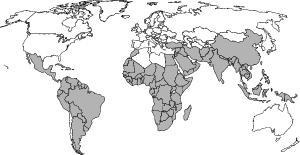Malaria: A Frustrating, Yet Curable, Disease
A Frustrating, Yet Curable, Disease
Malaria is a curable disease if diagnosed promptly and adequately treated. In China, an infusion of the qinghao plant has been used for at least the last 2,000 years to relieve malaria symptoms. The bitter bark of the cinchona tree was used in Peru before the fifteenth century for the same purpose. Quinine, the tree's primary active ingredient, was isolated in 1820. For nearly 300 years and until the 1930s, quinine was the only effective agent for the treatment of malaria. But it is now only used for treating severe malaria because of undesirable side effects. Common side effects include stomach cramps, nausea, diarrhea, and vomiting. Less common side effects can be dizziness, ringing in the ears, skin rash, and visual disturbances.
Infectious Knowledge
A gin and tonic a day keeps malaria away. Not quite. The popular alcoholic mix contains 20 milligrams of quinine per six fluid ounces. A typical daily dose of quinine for malaria treatment is more than 1000 milligrams per day. However, party-goers can thank malaria for the origin of the “Gin and Tonic,” since to make quinine's bitter taste more palatable, British colonials in India mixed it with gin and lemon or lime. Tonic water was granted an English patent in 1858.
Various alternatives to quinine have been used since the 1930s, yet they each had negative side effects that limited their application, or the bacteria developed strains that were resistant to the treatment. Today, drug-sensitive malaria is largely controlled by intravenous (IV) chloroquine, while drug-resistant forms are treated with quinine or quinine-derivatives combined with antibiotics.
The emergence of resistance to widely used antimalarial drugs such as chloroquine has greatly limited the control and treatment of malaria in certain countries. The extensive use and misuse of antimalarial drugs has contributed to the spread of resistance. It is important for drugs to be used properly, and in combination when necessary. New drugs would be helpful in this area, too.
Malaria's Many Costs
The economic burden imposed by malaria is enormous—the disease strains limited health-care resources and diminishes productivity.

World map showing areas (shaded) where malaria is ever-present, or endemic. (World Health Organization, 1997)
Potent Fact
Global warming and other climatic events, such as El Nio, help spread malaria to different geographic regions by influencing mosquito breeding sites, which leads to disease transmission.
In endemic areas, 3 in 10 hospital beds are occupied by victims of malaria. Seasonal malarial outbreaks can devastate farms as they frequently coincide with the rainy season and harvest time.
The direct and indirect costs of malaria in sub-Saharan Africa exceed $2 billion. According to UNICEF, the average cost for each nation in Africa to implement a malaria-control program is estimated to be $300,000 a year, which amounts to about six U.S. cents ($.06) per person for a country of 5 million people. Regrettably, limited resources often prevent such an investment, so malaria lives on.

Excerpted from The Complete Idiot's Guide to Dangerous Diseases and Epidemics © 2002 by David Perlin, Ph.D., and Ann Cohen. All rights reserved including the right of reproduction in whole or in part in any form. Used by arrangement with Alpha Books, a member of Penguin Group (USA) Inc.







